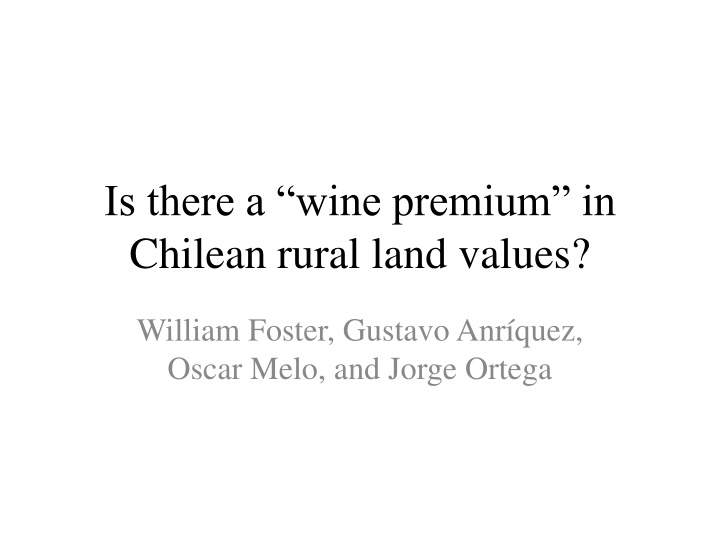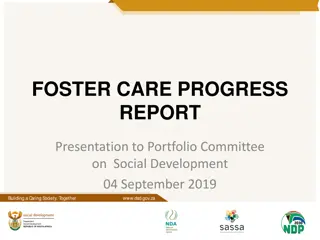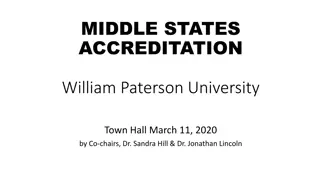
Chilean Rural Land Values & Wine Premium Factors
Explore the factors influencing rural land values in Chile, with a focus on potential impacts of climate scenarios and the contribution of wine grape cultivation. Consider how geographic characteristics and specific agricultural activities affect land values in Chilean comunas.
Download Presentation

Please find below an Image/Link to download the presentation.
The content on the website is provided AS IS for your information and personal use only. It may not be sold, licensed, or shared on other websites without obtaining consent from the author. If you encounter any issues during the download, it is possible that the publisher has removed the file from their server.
You are allowed to download the files provided on this website for personal or commercial use, subject to the condition that they are used lawfully. All files are the property of their respective owners.
The content on the website is provided AS IS for your information and personal use only. It may not be sold, licensed, or shared on other websites without obtaining consent from the author.
E N D
Presentation Transcript
Is there a wine premium in Chilean rural land values? William Foster, Gustavo Anr quez, Oscar Melo, and Jorge Ortega
Some questions regarding Chilean rural land values Main question: What factors explain rural land values in Chile? A motivating concern: Can we anticipate the impact on land values of possible future climate scenarios? An additional question: Beyond characteristics of a geographic area related to future income- generating potential (e.g., soil types, climate, distance to markets and likely future demographic trends), does information regarding specific activities add to our ability to predict land values?
Specifically, to what degree might wine grape cultivation contribute to a rural areas land values? The value of rural land in a geographic area (such as a county) should reflect the present discounted value of future income streams from farming activities and (as yet unrealized) potential residential use. We look at Chilean comunas municipalities. Once one has accounted for all of a geographic area s relevant characteristics, it would be reasonable to presume that per-hectare land values should be predictable in a cross-section without reference to the specific composition of agricultural activities taking place at a given time.
If land use decisions are optimal, basic characteristics should determine profit-maximizing crop mix at a specific place and point in time. There is, however, the possibility that a particular type of land use, such as wine grape cultivation, might be associated both with significant immobile investments, such as plantations, the value of which should be bid into vineyard values, and with other activities, such as wineries and tourism, which have external effects on the value of all land in the surrounding area. So land use composition could offer additional information regarding area-wide land values beyond that of the area s intrinsic characteristics of climate, market access, soil types, etc.
Example: Simple von Thunen model : land value is proportional to yearly rent, which depends on activity selected. Activity net income depends on value of crop sales at center and cost of transport. Activity A is a high-value perishable, C is durable, bulk commodity. Yearly rent per hectare Activity A Activity B Activity C 0 Distance from markets / market potential
Empirical approach Let s look at the correlation between rural land values at the municipal level and basic factors: climate, market potential, and others. Then add farm activities in comunas does this add information or is it redundant? Account for geographic correlation and possible spillover effects. Results are exploratory and needs refining.
Land value data Two sources of Chilean rural land value data: Classified ads for sales offers (Revista del Campo) Transactions recorded in CBRs registries. We use data from 37 land registry offices out of the 118 CBRs in total covering full area of study. Registries were selected randomly in a stratified sampling framework to ensure adequate geographic coverage. The geographic unit of analysis is the municipality. 15 agro-ecological zones and 5 macro zones (north to south) combined to 28 strata. In each stratum, the sample of 1-3 CBR were chosen with probability proportional to number of farms.
Land value data Data for 1980, 1990, 1997 and 2007 were gathered from recorded land transactions in 37 land registries covering 9 regions and 178 municipalities from Region III to Region X. After processing the basic data, information is available for land area and per-hectare values for 32,453 individual land transactions. Initial analysis of the real (cost-of-living- corrected) value per hectare of land shows that parcel values vary significantly according size and region.
Count of recorded rural transactions by Chilean Region and Year Regi n 1980 1990 1997 2007 3 63 143 4 307 242 5 329 485 6 1,040 971 1,367 1,237 4,615 7 1,639 1,345 2,033 2,561 7,578 8 824 1,092 1,436 2,576 5,928 9 753 1,062 1,685 2,543 6,043 14 267 310 10 319 424 1,097 1,442 3,282 Total 5,541 6,074 8,788 12,050 32,453 Total 521 988 2,246 120 238 560 195 201 872 252 423 1,252
Median number of hectares in recorded transactions Regi n 3 4 5 6 7 8 9 14 10 Total 1980 31.00 16.70 9.09 10.40 15.85 34.40 40.00 47.50 44.20 17.80 1990 8.50 2.50 0.76 2.00 2.62 5.00 8.74 9.91 8.40 3.81 1997 5.42 2.26 0.75 2.04 1.50 3.00 4.21 5.48 1.26 2.04 2007 1.96 0.51 0.73 1.00 1.45 2.10 4.20 3.00 1.09 1.78 Total 5.20 3.60 0.97 2.98 3.15 3.70 6.00 9.94 2.23 3.40
Our variable of interest: Median value per hectare in UF in recorded transactions. Regi n 3 4 5 6 7 8 9 14 10 Total 1980 13.25 15.92 27.77 39.32 14.03 7.57 7.86 14.30 10.30 14.86 1990 6.15 52.12 238.03 89.65 64.50 17.85 12.86 21.97 18.26 32.16 1997 20.88 62.07 703.20 194.63 125.12 42.60 47.28 41.61 142.00 90.40 2007 144.44 652.70 591.88 366.34 154.01 66.36 51.84 91.90 108.77 107.80 Total 38.73 49.05 375.38 131.14 73.68 38.41 30.27 34.06 71.12 59.17 We use the median values per hectare in UF in recorded transactions at the municipality level 89 comunas for 4 years
Basic conceptual model of land values The final assumption is that the observed value of parcel j , Vj , is the maximum value over all possible activities (a = 1,2, ,A): = ln max ln ,ln ,...,ln V V V V 1 2 j j j Aj As Schlenker, Hanemann and Fisher (2009) note that, if in the decomposition of the error term into a parcel effect and an activity effect (uaj = vj + a), the error associated with the activity effect is not extreme-value distributed, then there is no closed-form solution for the expected value of the value equation; and the generic hedonic expression j = X + ln V j j is an approximation to the land-value envelope of the possible rents over all activities.
Looking only at activities, certainly there is a strong correlation with median municipal land values and whether or not comuna has vineyards and fruit production. Or can we explain this by more basic characteristics? Land value per hectare in the Municipalities of Chile If the municipality has Vineyard more than 1% of agricultural area 600 500 400 UF/HA 300 200 100 1997 2007 Land value per hectare in the Municipalities of Chile No yes If the municipality has Fruits more than 5% of agricultural area 500 Wine grapes 400 UF/HA 300 Fruit 200 100 1997 2007 No yes
Spatial Durbin model SDM available in Stata includes both endogenous and exogenous interaction effects (LeSage and Pace, 2009; Elhorst, 2010; Vega and Elhorst, 2013). W is determined by distance (inverse). We use random effects, because with fixed we lose the climate information. = M SEM : spatial error model
Xs What explains per-hectare land values? - Size of the transaction (parcel size), climate, soils, distance to markets and population centers, local population density. Land prices and Land size Mean data at Comuna level Median data at Comuna level 15 10 10 5 ln(UF/Ha) ln(UF/Ha) 5 0 0 -5 -5 0 2 4 ln(Hectares) 6 8 10 0 2 4 6 8 ln(Hectares) lnUF_HA Fitted values lnUF_HA Fitted values R-sq=0.05; Beta=-0.26; n=503 R-sq=0.45; Beta=-0.77; n=503
Market potential is an index summarizing the distance-weighted incomes of markets near and far: Region 3 13.84 4 5 6 7 8 9 10 14 mean lnMP R = 14.78 18.09 17.94 17.21 17.27 16.15 15.34 16.58 (1 ) d MP Y e G rs r s s = 1 s ( ) = h s , G G w p s s Incomes and prices vary over time, parameters from F lix Modrego, Philip McCann, William E. Foster, M. Rose Olfert. 2014. Regional Market Potential and the Number and Size of Firms: Observations and Evidence from Chile. Spatial Economic Analysis, 9(3): 327-348. ------- 2015. "Regional entrepreneurship and innovation in Chile: a knowledge matching approach." Small Business Economics. 44(3): 685-703.
Climate variables Meteorological stations are not optimally positioned for used by economists
Climate variables Average and standard deviation of temperature and precipitation, annual, based on monthly records for 533 weather stations from 1964-2012. Municipal stats based on weighting stations based on distance. 20 15 Degrees Celsius 10 5 1 2 3 4 5 6 7 8 9 10 11 12 Month Rancagua_100km Osorno_100km Los_Angeles_100km Carahue_100km Curic _100km Parral_100km Pitrufqu n_100km Talca_100km San_Felipe_100km
More X variables Municipalities are classified by urban/rural-ness, essentially according to population. 6 types from very rural to metropolitan. RIMISP Berdegue, et al., 2011. Whether or not there is mining in the comuna. 7 agro-ecological zones: soils, valley vs. piedmont, dryland vs. irrigation availability, and volcanic/sandy, good for grains. Percentages of various types of ag activities from Ag census: Annual field crops Grasslands, pasture Forestry Fruits Vineyards Others: fallow, marginal, structures, unused. Problem: While there is variation cross-section, the % of fruits and vineyard do not change very much over time. But, yes, for crops and forestry.
Summary of results With a dummy variable (comuna > 1% of land in vineyards) close to SAG classification. Two periods with Ag Census data for crop proportions by municipality: 1997 and 2007. Using four periods (1980, 1990, 1997, 2007) with simple % of plantings in 1997 or 2007, or their average. Comparison of results : OLS, RE, SAR, SEM, and SDM.
SDM with random-effects Number of obs 356 Group variable: Comuna2 Number of groups 89 Time variable: periodo Panel length 4 lnUF_HA Coef. -0,40 0,13 6,50 -0,26 3,29 -0,14 -0,38 -0,15 0,00 -2,56 Std. Err. 0,04 0,03 2,36 0,83 2,00 0,07 11,65 0,04 0,00 4,80 z P>z 0,00 0,00 0,01 0,75 0,10 0,04 0,97 0,00 0,00 0,59 -8,95 3,87 2,75 -0,32 1,64 -2,02 -0,03 -3,63 3,58 -0,53 lnDimensi n Ln(market pot. Index) Vinas % ave 9707 Fruit % ave 9707 T_mean T2_mean T_cv PP_mean within between = 0,85 overall = 0,76 PP2_mean = 0,80 PP_cv
lnUF_HA Regi n2 5 6 7 8 9 14 Macro_zonas2r Precordillera Secano costero Secano interior Trumao lomaje Valle de secano Valle riego TipoTF Metropolitano (mayor 250m) Rural pluricomunal Rural unicomunal Rural-Urbano (C18-40m) Rural-Urbano (C40-80m) Coef. Std. Err. z P>z -1,10 -0,97 -0,39 -0,67 -0,58 0,06 0,92 -1,200,23 0,69 -1,410,16 0,57 -0,680,50 0,40 -1,660,10 0,28 -2,060,04 0,96 0,060,95 0,48 0,09 -0,09 0,65 0,60 0,21 0,21 2,290,02 0,26 0,350,73 0,26 -0,350,73 0,25 2,640,01 0,20 2,930,00 0,23 0,920,36 -0,03 -0,35 -0,22 -0,28 0,19 0,22 -0,130,90 0,20 -1,730,08 0,20 -1,120,26 0,25 -1,140,26 0,22 0,880,38
Bottom line: there is something valuable about having vineyards. From dummy model: Municipalities with vineyards have 25-50% higher median land values than otherwise, controlling for climate, soils, market potential, etc. From % vineyard model: A 1 point increase in percentage in vineyards increases median value by at least 3%, but in most models 5-7%, relative to other uses mainly marginal land, fallow and structures. Plus indirect effects, total impact reaches 10 to 20%. Ceteris paribus, the proportion of land in fruit production does not add any information. Ditto for other activities. This suggests that the added value of vineyard is more than the value of plantations.
Other results Climate important: higher median temperatures, higher land values, decreasing rate. Lower precipitation, higher land values, decreasing. As expected, market potential important. Ceteris paribus, increasing MP from that of the region with the least to that of the highest, the gain in value is on the order of 40% Elasticity of transaction size is about -0.4.
Possible sources of wine premium in a municipality s median per-hectare value. Missing variables: endogeneity everywhere? Terroir? Special and significantly larger land-tied investments associated with wine grape production, more than fruit plantations. Spillovers onto value of all land of having local wine and wineries the cachet, prestige associated with having a property or (second?) home in a wine region. Wineries, tourism
Future detective work Is it just wine as an aggregate? We have plantings by variety and asking prices from classified ads, which contain more information regarding property aptitudes. Shorter time span. Tourism - is it the presence of wineries, not just the vineyards? Locate wineries, but all or just of a prestige level? More, better information on basic characteristics.






















